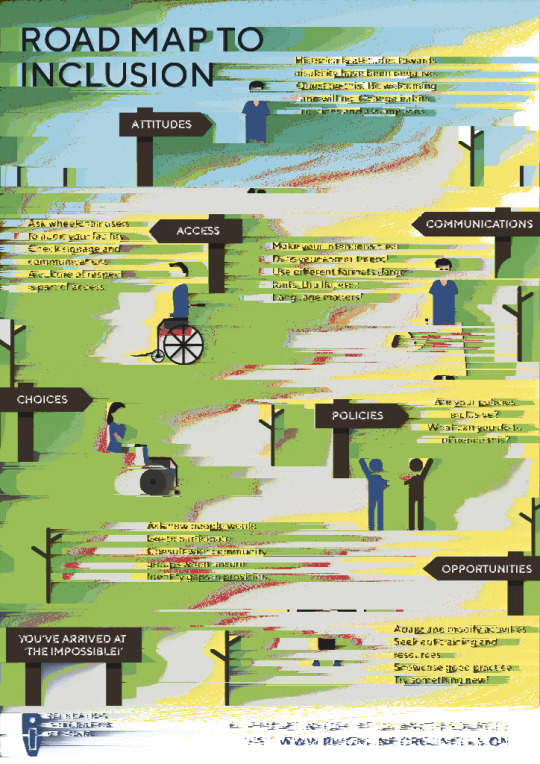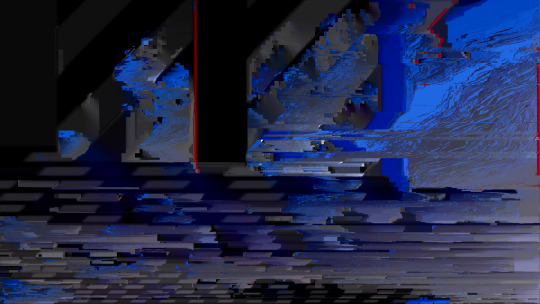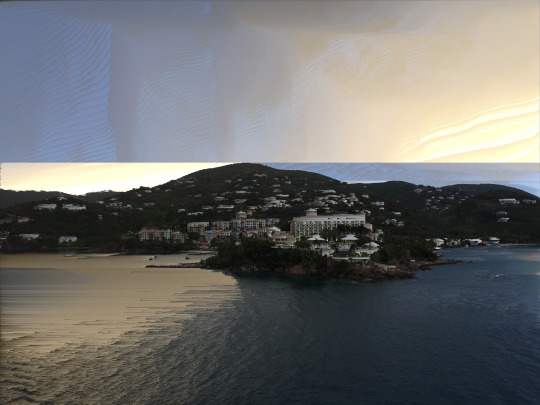#ASDFPixelSort
Explore tagged Tumblr posts
Text



corporate infographic pixelbending with ASDFpixelsort
I am interested in modern infographics as ideological tools. I am also interested in how ubiquitous and invisible they are. It is interesting to see how much actual information you can take away from them, to see if they are still legible.
This is a very cynical project. The first image looks like something a boss might print from the internet at low res so it is barely readable.
I like the idea of taking any educational function away from them so that they are purely good intention and gesture.
0 notes
Photo

data smash
39 notes
·
View notes
Photo

liberty17-01.jpg
1 note
·
View note
Note
Your work is excellent. What do you use as source material, and have you considered making prints?
Thank you so much, I really appreciate that!
I use my own photos for all my images and process them with Kim Asendorf’s ASDFPixelSort and Paul Hertz’s GlitchSort.
As for prints, I’m planning on making some test prints this weekend. I’ll (hopefully) have some prints available to purchase soon.
1 note
·
View note
Photo

Your Mother is a Glitch Tecnica: Pixel Sorting. Una modificacion del script de Kim Asendorf (ASDFPixelSort) que un tal Julescarbon ha colgao en GitHub. Alucinante y tambien incontrolable... http://bit.ly/2U20kPO — view on Instagram http://bit.ly/2BIYpbH
0 notes
Photo





Exhibition Day (Wk 12) + feedback sheet
Note- I haven’t included the code for all my finals because:
A- theres a lot of images/ outputs that went into my final presentation.
A (i)- because of that and there only being marginal changes of the code between images, it would be very time consuming for me catalogue and post, as well as you, reader, to scroll through.
B- I’ve basically already included the code in previous posts. I’ve highlighted the parts that change in the code for each image in specifically the Zine Attempt posts from Wk 11, but the code is scattered throughout the blog.
And again, the original code that I adapted for my final outputs come from
The Coding Train (Daniel Shiffman) [Floyd Steinberg Dithering] > https://youtu.be/0L2n8Tg2FwI
Kim Asendorf [Pixel Drifting] > https://github.com/kimasendorf/ASDFPixelSort
Phil [Channel Shift Glitch] > http://datamoshing.com/2016/06/29/how-to-glitch-images-using-rgb-channel-shifting/
so really the credit goes to them, I just chose some cool images and fiddled with the values.
0 notes
Text
Blog #4 - ASDFPixelSort
This set of pictures are generated by artist Kim Asendorf ‘s ASDPixelSort algorithm. The basic idea behind this algorithm involves two different steps: first, the rows/columns of the image are split into “intervals”. Next, the pixels in each interval are rearranged so as to sort them with respect to some property, for example, lightness. Kim Asendorf’s code simply applies this technique twice: first vertically, then horizontally. The intervals are defined by regions of the image that are too light or too dark – the edges of these regions define the edges of the intervals.




0 notes
Text
SUPPORTING RESEARCH ON GLITCH AND GLITCH ART
The Glitch
As I have said in previous posts, the glitch is a particularly relevant notion for the right understanding of this installation. In this essay, I will explain my interpretation of this key concept to better understand its use within the project. The glitch has been conceptualised as the tangible and visual manifestation of something unexpected: the irruption of the unplanned (Virilio, 2003; Virilio & Lotringer, 2005). In digital culture the glitch has been described as “an artifact resulting from an error” (Moradi, Scott, Gilmore, & Murphy, 2009:8), signalling something gone astray in the works of the machine: the machine caught in the act of revealing itself. As such, the computer glitch is an event equally maddening and enchanting: maddening, because it disrupts expected and predictable sequences; enchanting, because it offers a glimpse of something that is usually hidden behind the screen (Marenko, 2014, 2016). For this reason, the project is proposing to consider the glitch as something that empowers the machine because of its unpredictability and its alien characteristic that make it incomprehensible and uncontrollable to human, but also as something that goes against the transparency of media to make the audience aware of the medium itself: “A glitch is an unexpected moment in a system that calls attention to that system” (Britz, 2015:4).
“The glitch is an act of subversion, the machine now dictates the rules, rather than obeying them” (Menkman, 2011:30). Within this crumbling of expectations, the machine no longer behaves how it is supposed to, therefore the glitch can be read as the “creative process within a machine or program” (Menkman, 2011:5). Glitchy media establish a creative authority separated from that of the author, even when the brokenness is a direct result of actions taken by a human, the machine still gets a part of the action and it gets to express something of itself. Daniel Temkin defines glitch as “a cyborg art, building on human/computer interaction. The patterns created by these unknown processes is what I call the wilderness within the machine” (2014). Therefore, when approached this way, Glitch Art becomes “ a study of the dialogue between us and the machine, allowing us to share control of the project with the machine itself” (Temkin, 2014 ).
Glitch art
Glitch artists are concerned with finding the ‘Soul in the Machine,’ a sense of liveness within a computer or a program that allows the machine to be considered as an entity on its own. One of the most compelling ideas to my project comes from James Bridle's New Aesthetic (2012). In his essay he talks about how the glitch allows us to treat the machine as having a vision—even though we know it's not sentient—and just how strange this vision is, that does not hold human beings as its audience (2012). Curt Cloninger describes glitch art as "painting with a very blunt brush that has a mind of its own” ( cited in Temkins, 2012), glitch artists have been doing this for a long time, treating the machine as an equal collaborator and seeing where it leads them as they cede control to broken processes and ‘zombie algorithms’ (Temkins, date). Many of them have tried to allow the machine to function as an agent with its own agenda, by exploiting the uncontrollability and unpredictability of the glitch event. An example, which is very pertinent to the theme of this project, is the conversation between two algorithmically driven glitching bots on Twitter (Fig. 1). It began after Bob Poekert's @a_quilt_bot sent a glitched image to @pixelsorter, a bot whose algorithms turn images into pixel-sorted glitch art, @pixelsorter sent @a_quilt_bot an image in return, signalling the beginning of a conversation in which the only participants were machines.
The Invisible (Prototype N°1) is a computer-generated digital installation (Fig 2) in which the artist HiraKawa exploits the glitch event in order to call attention to the system in itself. The artist builds a tangible demonstration of data flow and coding, allowing visitors to see “the abstract figuration of computing processes as they unfold before our eyes” making them aware of the medium existence and importance.
Most practitioners, as I will attempt to do with my project, have looked at the glitch event as a glimmer into the ‘soul of the machine,’ as something that gives the machine a sense of liveness and allow us to give up control to a computer or program. Despite this, during my research process, I have investigated further on the meaning of glitch and the different interpretations that various glitch artists have assigned to it. Not all glitch artists are driven by the same impetus when approaching Glitch Art. For instance, many of them are exclusively motivated by the aesthetic potential of glitches —like Phillip Stearns’ Glitch Textiles (Fig.1) where he rendered the invisible language of digital technologies into textiles, or Rosa Menkman in her study A Vernacular of File Formats on the aesthetic of glitch effects on different file formats (2010).
Some glitch artists are interested in the glitch’s political potential like Benjamin Gaulon in Retail-Poisoning (Fig 2) where he intentionally inject corrupt / fake / glitched data and/or hardware, in existing online and offline retail outlets. Other artists have investigated the glitch’s psychedelic potential (Fig 3) , while others see Glitch Art as a mean to explore themes of memory , entropy , nostalgia , to call attention to the growing mediation of our social relationships or as a lens through which to analyse gender and identity .
As explained before, Glitch Art is a practice that has been very welcomed in the digital media community. Many artists have had different interpretations of the glitch event and Glitch Art. Above, there has been a selection of the works that I have found most inspiring during my research. The list below contains the links to some other artists, researchers and key texts that I have looked at to expand my knowledge in this field, and more in general, in the field of digital art: Significant Practitioners and Researcher Rosa Menkman – – http://rosa-menkman.blogspot.ca Matt Pearson – http://zenbullets.com Philip Galanter – http://philipgalanter.com Nick Briz – http://nickbriz.com Matthew Fuller – http://www.spc.org/fuller Jon Satrom – http://jonsatrom.com Michael Whitelaw – http://mtchl.net Glitchr – https://www.facebook.com/glitchr Daniel Tempkin – http://danieltemkin.com Paul Hertz, GlitchSort, http://paulhertz.net/factory/2012/08/glitchsort2/ Kim Asendorf, Pixel Sort, https://github.com/kimasendorf/ASDFPixelSort
1 note
·
View note
Photo

// W H E N T H E S K Y B L E E D S // - 2K15
107 notes
·
View notes
Photo

liberty17-17.jpg
0 notes
Photo

I'll have what you're having,
- Hendrix Nash
#Hendrix Nash#Pixel Sort#ASDFPixelSort#Glitch Art#Glitch Artists Collective#Digital Art#Artists on Tumblr
66 notes
·
View notes
Photo

#Glitch Art#Glitch#Processing#ASDFPixelSort#Pixel Sort#Pixel Sorting#Photoshop#Digital Art#Art#Datamosh#Datamoshing#Pixel Art
30 notes
·
View notes
Photo

#glitch#glitch art#databending#databent#ASDFPixelSort#asdf pixel sort#Audacity#delaunay triangulation#Delauney Triangulation#pixel sorting#pixel sort#pixel drift
10 notes
·
View notes
Video
youtube
ASDFPixelSort BIRDS - Arash Saidi
#Glitch Artists Collective#Glitch#Glitch Art#ASDFPixelSort#Arash Saidi#Video Glitch#Digital Art#Artists on Tumblr#Processing
7 notes
·
View notes
Photo

guys please help me - is this glitch white and gold, or blue and black? Me and my friends can’t agree and we are freaking the fuck out
0 notes
Photo

// D O N T L O S E Y O U R H E A D // - 2K15
#databending#databend#glitch#pixel sorting#asdfpixelsort#digital art#vaporwave#seapunk#crt#computer#code#glitch art#databent#data bent
54 notes
·
View notes